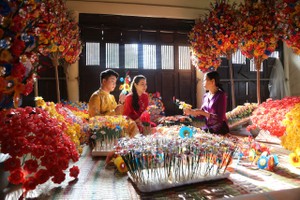With over 3,000km of coastline and thousands of offshore islands, Việt Nam is home to a wide range of species, including marine turtles.

However, the animal considered part of the national heritage and the ambassador of the ocean is endangered globally due to human activities and climate change.
Every year, the International Union for the Conservation of Nature cooperates with Côn Đảo National Park to launch a Marine Turtle Conservation volunteer programme, aiming to promote community-based conservation of sea turtles and their habitats.
Chosen from more than 1,100 applicants nationwide, 12 of us are fortunate enough to become members for the programme and were assigned to the three big islands of Bảy Cạnh, Tre Lớn and Cau, all home to many turtles in Côn Đảo National Park.
Volunteering on Bảy Cạnh Island left me with a life-long impression of this globally endangered marine animal.
Our work usually started at midnight and ended in the early morning of the next day, depending on the tides.
We patrolled white sandy beaches with the game wardens. Even from far away, the wardens easily spotted the tracks of turtles crawling ashore or back to the sea, while we strained our eyes in the dark, trying and failing to see anything.
We monitored the turtles’ activities, using information garnered from their tracks. We watched turtles digging their nests, preparing to lay eggs, and refilling their nests with sand.
Our work proved easiest after the turtles finished digging their nests and while they prepared to lay eggs. At such times, we just had to wait to catch each falling egg, place them in baskets, and then move them to the incubation area.
We needed to be very gentle and calm whenever we discovered a turtle about to dig a nest. No talking or torch-lights were allowed because the turtle might creep away.

Our work proved most difficult after the turtles had finished refilling their nests with sand. Then we needed to mark the nest locations, carefully search for eggs, and gently remove them from their nests.
The incubation area featured sand holes dug in advance by the turtle conservation centre. Eggs taken from their natural nests were moved to the artificial "nests" that were then covered with sand for their safety and to increase the hatch rate.
It normally takes turtle eggs 45 to 50 days to hatch into baby turtles. The sex of the baby turtle is determined by the incubation temperature.
The final task of our day was releasing newly hatched baby turtles into the sea. The hatchlings were released about 10m from the sea because this helped them find their way using sound and light. They might return to this beach 30 years later to lay their eggs here like their mothers did.
The survival rate of a sea turtle in nature is only 1 per 1,000. Seeing the newly hatched babies swimming across the waves, we could understand how hard is their process of giving birth, developing and struggling to survive.
New skills
The days on Bảy Cạnh Island have trained us in so many new skills, like discovering the turtles based on their tracks in the sand, figuring out whether they had laid eggs or not, taking out the eggs while the mother turtles were laying or marking the location of their nests.
In order to take out the eggs, we had to dig our own holes right behind the turtle’s tail. Then we had to lay down on the sand, catching the eggs and digging sand almost at the same time.
Our faces and hair were full of sand each time we laid down to catch an egg, but holding the warm eggs in our hands gave us the mixed feeling of both great excitement and pride.
As soon as the mother turtle finished her work, it was more convenient for us to embark on measuring and tagging her when she was taking a break. After we had measured the width and length of her shell, small tags would be stuck into the front flippers to identify the turtles that had nested on the island. Thanks to those small tag that provide important information, the turtles of Côn Đảo Islands can easily be identified wherever they travel to, even as far as the Malaysia Sea.

Conservation efforts
Côn Đảo National Park presently has 14 beaches, covering an area of thousands of square kilometres and providing nesting locations for various kinds of marine turtles, including green, hawksbill, leatherback and Olive Ridley turtles.
“From January to the end of August this year, the mother turtles dug about 2,000 nests on the islands, eggs from 978 nests were hatched and 79,481 baby turtles were released back into the sea,” says Nguyễn Đức Thắng, the manager of the Department of Marine and Wetland Conservation of Côn Đảo National Park.
In each breeding season, the mother turtle might lay eggs from two to ten times, each of which is about ten to 14 days apart. The rate of successful hatching is up to 84 per cent.
Their nesting season normally takes place from May to September, focusing on several large islands of Côn Đảo. Trading in sea turtle products including their eggs is strictly prohibited, but they still attract thieves because of their high economic value.
In fact, turtle eggs are not as nutritious as many may think, because their cholesterol level is 20 times higher than those of chickens and ducks, which might cause hyperlipidemia, stroke or heart attack.
According to Thắng, since 1994, the management board of Côn Đảo National Park has conducted a variety of methods to protect the endangered marine animals and increase their chances of survival.

The methods include preserving their natural habitat, moving the eggs to five incubation grounds in the park, examining and releasing the baby turtles to the sea, studying their biological features by measuring and tagging the turtles, as well as tightening up patrols.
Though it has received much attention from the local authority and has garnered international assistance, the conservation of sea turtles on the islands still faces many challenges.
“Côn Đảo National Park encounters financial difficulties in purchasing equipment for research and moving the eggs, and to set up command posts to guard the nesting areas of the turtles,” Thắng says.
Meanwhile, the number of the forest wardens is limited in comparison with the vast area of the islands. Perhaps because of the lack of penalising regulations, the illegal taking of nesting females and their eggs still takes place regularly.
Threats to marine turtles have also increased due to the accidental and opportunistic capture by fishermen; the commercial hunting of turtles for their shells for the international market, and pollution in their natural habitat like resource over-exploitation, waste and plastic bags.
“The effectiveness of protecting this endangered sea animal therefore needs each individual and relevant organisations to join hands in the fight against the illegal trade in sea turtles, and environment pollution, which is of crucial importance to ensure the ecological balance of both Việt Nam and the world at large,” he added.


























